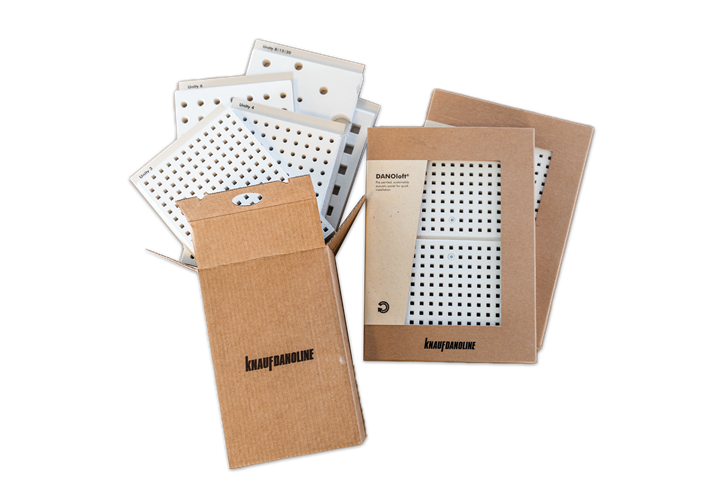Sound is just as vital for a building as lighting or air. Humans spend up to 90% of their time indoors, so acoustics in their environment strongly influence how they feel. Is it too noisy? Is it deafeningly silent? Finding the right sound balance for a given space is critical in architectural design because its success or failure sets the tone for the rest of the interior. The process of ensuring acoustic comfort, then, is like composing the soundtrack of a building.
The Soundtrack of a Building: The Role of Acoustic Comfort in Architectural Design

Why acoustic comfort matters
Acoustic comfort is an overall feeling an individual has in a space or a building regarding sound quality. In architectural design, ensuring acoustic comfort or auditory wellness refers to taking measures to eliminate or suppress noise, enhance speech, or improve sound transmission.
We quickly notice a lack of light or detect unpleasant odours. The same can be said about acoustics. From excessive noise to annoying tunes or loud meeting rooms, there are many ways poorly addressed sound issues can affect our well-being indoors. Even subtle disturbances in acoustics can disrupt acoustic comfort. Over 50% of workers report getting interrupted by noise distractions more than five times every day, with 17% stating that they are interrupted more than 10 times a day.
What should a building sound like?
People have different expectations about the acoustic setup depending on which indoor space they occupy. High volume would be taken for granted at an event venue, lots of noise forgiven in an airport but a much more peaceful environment expected at home.
The purpose of the building will determine its sound. An office will require more effort to contain noise in designated areas, such as the canteen or conference rooms, while allowing for calm and focus around workstations. A concert hall design would have to accommodate measures to control echoes and how music travels indoors.

The Sound of Life: learn more about acoustic design
In this ebook, you can dive deeper into how acoustics affect our everyday lives no matter where we spend our time: at home, at work or at school. Learn how important it is to consider the acoustic properties of the materials you choose to install, and how you can ensure the optimal design from the beginning of the design phase.
First steps to acoustic comfort
Lousy acoustics can negatively influence work life, disturb rest time and even affect health. Many buildings in contemporary architecture include hard surfaces such as concrete, glass or other materials with limited acoustic qualities contributing to poor acoustic comfort.
Ensuring auditory wellness starts in the design process when acoustic materials to control sound absorption, diffusion and reverberation time are selected. Additional aspects, such as ventilation, must be considered. For example, perforated gypsum tiles achieve three acoustic design goals in one: acoustic comfort, ventilation, and aesthetics. Architects and building residents want a visually appealing solution that optimises sound control and lets in fresh air.
Chosen acoustic materials should have properties to support sound diffusion to distribute sound evenly throughout a space at different frequencies. Depending on the building, specific limits to reverberation time might be set, which also must be considered. The higher the ceilings, the longer the reverberation time and the more sound absorbers are needed.
How Petershagen Kindergarten achieved acoustic comfort with gypsum ceilings
Creating a favourable acoustic environment was one of the main concerns for architects behind Petershagen Kindergarten in Germany. With up to 100 children playing and romping around, the interior design set high standards for acoustic performance to ensure comfort for children and teachers.
The challenge: Rooms of varying sizes, low ceilings, and lots of interaction
Petershagen Kindergarten is run using the Montessori approach. Rather than enforcing formal teaching methods, children are encouraged to unfold their potential by exploring the environment freely.
The unique concept entails lots of interaction among children in rooms of varying sizes. Children are cared for in smaller groups in dedicated rooms, but depending on their development and needs, they can go out and explore other rooms, including a larger open area.
Different open rooms with low ceilings and shifting noise levels posed a unique challenge to the kindergarten architects. The building acoustics had to comply with the requirements of German regulations, such as DIN 18041 and the reverberation time of 0,4 seconds.
The solution: 700 square metres of DANOLINE perforated gypsum tiles
The acoustic challenge at Petershagen Kindergarten was solved using DANOloft® acoustical panels from Knauf DANOLINE. DANOloft® are pre-painted white gypsum acoustic tiles with a minimalistic design.
No less than 700 square metres of perforated gypsum tiles were installed in a staggered pattern for a more graphic expression. In group rooms, DANOloft® was installed on a wood furring with a 40 mm mineral wool underlay to provide the best possible sound absorption.
The tiles were discreetly screwed on through perforation holes. There was no need for clean up, filling or painting because the tiles came pre-painted straight from the factory and could be mounted to the wooden structure easily with minimum debris.
Low ceilings are a common issue in acoustic design. Most absorbers tend to overtake a large part of the ceiling, reducing the space in the room. Petershagen had low ceilings and needed a solution that would not affect the height further. The finely perforated DANOloft® acoustic tiles are 600 x 600 mm in size and only 12.5 mm thick, which turned out to be an excellent fit for the kindergarten.

Order a sample and feel the quality
If you want to see, touch, and try out our Danoline products, you can order a product sample here. All our ceilings and walls are sustainable, certified and easy to install.
The result: Bright monolithic acoustic ceilings with effective noise reduction
Noise is absorbed perfectly with the robust gypsum acoustical panels. Next to acoustic comfort, the material is fire-resistant (A2 fire class), non-toxic, and 100% recyclable. A good indoor climate is ensured through the built-in air cleaning function.
DANOloft® acoustic tiles connect seamlessly, creating a monolithic, aesthetically pleasing look. Over time, gypsum ceiling tiles retain their original colour, but if needed, they can be repainted with no effect on acoustic performance.
And if children happen to kick a ball and break a tile, it can immediately be replaced with a new one, allowing for easy maintenance.
"The acoustics are very pleasant, especially in the large group room. During the first inspections and discussions, I immediately noticed how well the sound is absorbed."
Why gypsum is one of the best acoustic materials for kindergartens
All indoor spaces should be designed to ensure a healthy environment, especially those for children. Gypsum is a clean material with no risk of pollution – making acoustic gypsum ceilings a great fit to improve acoustic comfort and healthy indoor climate in educational institutions.
A wide range of perforated gypsum’s acoustical properties supports sound absorption and diffusion in all sound frequencies. Sound is absorbed through the perforation holes, and the edges of the perforation holes help diffuse sound. This helps perforated gypsum tiles comply with any building requirement regarding sound worldwide.
Pair that with aesthetics and ventilation, and you got a product capable of anything in acoustic design.

Our local consultants are ready to help you
Do you want to know more about the design possibilities and the acoustical properties of our products? Get in touch, and our local Area Sales Manager will help guide you and answer any questions you might have.



